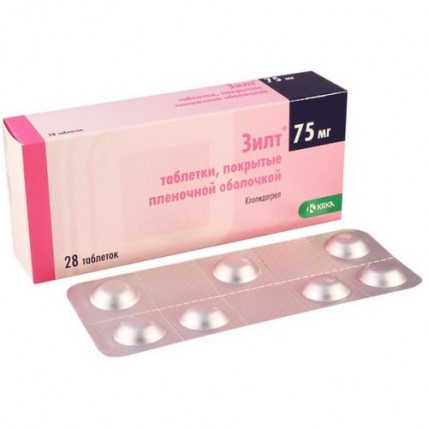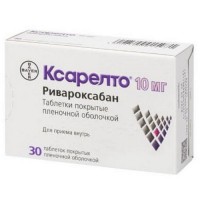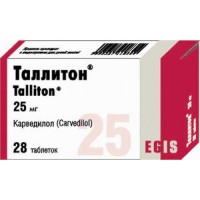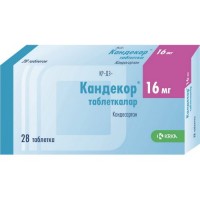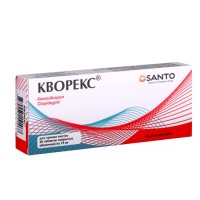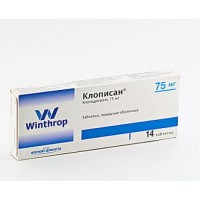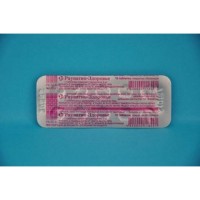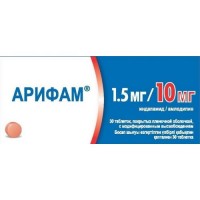Zilt® 28's 75 mg film-coated tablets
- $57.70
The instruction for medical use of Zilt medicine the Trade name of Zilt the International non-proprietary name Klopidogrel Lekarstvennaya the Tablet form, film coated, 75 mg Structure One tablet contains active agent - klopidogret hydrosulphate of 97.875 mg (it is equivalent to a klopidogrel of 75 mg), excipients: lactose anhydrous, cellulose microcrystalline, starch prezhelatinizirovanny, a macrogoal 6000, the castor oil hydrogenated a film cover: a gipromelloza, the titan dioxide (E171), talc, ferrous oxide red (E172), propylene glycol the Description of the Tablet of round shape, film coated pink color, slightly biconvex Pharmacotherapeutic group the Drugs influencing a hemopoiesis and blood. Anticoagulants. Inhibitors of aggregation of thrombocytes, excepting heparin. Klopidogrel the ATX B01AC04 Code klopidogret the Pharmacological Pharmacokinetics Absorption Later properties of single and repeated oral administration in a dose of 75 mg a day quickly is soaked up. Average maximum plasma concentration of not changed klopidogrel (about 2.2-2.5 ng/ml after single oral administration in a dose of 75 mg) were noted in 45 minutes after reception. Judging by the metabolites of a klopidogrel allocated with urine, absorption of not less than 50%. Distribution Klopidogrel and his main (inactive) metabolite which is in a blood-groove form reversible communication with proteins of human plasma (98% and 94% respectively). Binding is not saturable in the wide range of concentration. Metabolism Klopidogrel is exposed to intensive metabolism in a liver. Klopidogrel is metabolized in two main ways: one is mediated by esterases and leads to hydrolysis with education inactive derivative carboxylic acid (85% of the metabolites which are in a blood-groove), another is mediated by various P450 cytochromes. At first klopidogret it is metabolized to an intermediate metabolite, 2-oxo-klopidogrela. The subsequent metabolism of an intermediate metabolite 2-oxo-klopidogrela leads to formation of an active metabolite, thiol derivative klopidogrel. The active metabolite is formed in the main CYP2C19 with the participation of some other CYP enzymes, including CYP1A2, CYP2B6 and CYP3A4. An active thiol metabolite quickly it is also irreversible contacts receptors of thrombocytes, suppressing thereby aggregation of thrombocytes. Cmax of an active metabolite increases twice as after a single load dose of a klopidogrel of 300 mg, and after reception of a maintenance dose of 75 mg within 4 days. Cmax is observed approximately in 30-60 minutes after reception. Klopidogret removal After reception of a dose, the marked 14C, about 50% are allocated with urine and about 46% with stool within 120 hours after introduction. After a single oral dose of 75 mg the elimination half-life of a klopidogrel makes about 6 hours. Elimination half-life of the main (inactive) metabolite circulating in blood makes 8 hours after single and repeated receptions. The pharmacogenetics of CYP2C19 participates in education, both an active metabolite, and an intermediate metabolite, 2-oxo-klopidogrela. The pharmacokinetics and antithrombocytic effects of an active metabolite of a klopidogrel change depending on CYP2C19 genotype. The allele of CYP2C19*1 corresponds to completely functional metabolism whereas alleles of CYP2C19*2 and CYP2C19*3 are nonfunctional. Alleles of CYP2C19*2 and CYP2C19*3 cause the most part of alleles with reduced function at European (85%) and Asian (99%) slow metabolizator. Other alleles associated with the absent or reduced metabolism meet less often and include CYP2C19*4, * 5, * 6, * 7 and * 8. The prevalence of alleles of CYP2C19 of which average and slow metabolism of CYP2C19 is result was a miscellaneous depending on race / ethnic origin. The patient with the status of a slow metabolizator will have two alleles with the lost function as it is described above. Frequency of genotypes of a slow metabolizator of CYP2C19 corresponds to about 2% for Europeans, 4% of the African race and 14% of the Chinese origin. There are tests for definition of CYP2C19 of a genotype of the patient. Essential differences in exposure and on average the suppression of aggregation of thrombocytes (SAT) between ultrafast, fast and average metabolizator were not observed by an active metabolite. At slow metabolizator the exposure by an active metabolite was 63-71% lower in comparison with fast metabolizator. After use of the dose mode of 600 mg / 75 mg antithrombocytic response was lowered at slow metabolizator, at the same time the average of SAT (5 microns of ADF) made 24% (24 hours) and 37% (day 5) in comparison with 39% of SAT (24 hours) and 58% (day 5) fast metabolizator and 37% (24 hours) and 60% (day 5) - average metabolizator. When slow metabolizator were on the mode of 600 mg / 150 mg, exposure an active metabolite was more, than at the mode of 300 mg / 75 mg. Besides, made SAT 32% (24 hours) and 61% (day 5) that was more, than at the slow metabolizator which were on the mode of 300 mg / 75 mg, but similar to other groups of metabolizator CYP2C19 which was on the mode of 300 mg / 75 mg. The corresponding dose mode for this population of patients was not set. Exposure by an active metabolite was reduced by 28% at average metabolizator and for 72% at slow metabolizator whereas suppression of aggregation of thrombocytes (5 microns of ADF) was reduced with a difference in SAT in 5.9% and 21.4%, respectively, when comparing with fast metabolizator. Special populations the Pharmacokinetics of an active metabolite of a klopidogrel in these special populations is unknown. The renal failure After repeated doses of a klopidogrel on 75 mg a day at patients with a serious illness of kidneys (clearance of creatinine from 5 to 15 ml/min.) suppression of the aggregation of thrombocytes caused by adenosinediphosphate (ADF) was weaker (25%), than at healthy, however the patients receiving 75 mg of a klopidogrel a day had a similar lengthening of a bleeding time. Besides, all patients had a good clinical tolerance. After repeated doses of a klopidogrel on 75 mg a day within 10 days the patients with a heavy abnormal liver function oppression of the aggregation of thrombocytes caused by ADF had a similar abnormal liver function at healthy. Average lengthening of a bleeding time in both groups was similar too. The race Prevalence of alleles of CYP2C19 which consequence average and bad metabolism of CYP2C19 is changes depending on race / ethnic origin (see. Pharmacogenetics). For assessment of clinical consequences of influence of a genotype of this CYP for a clinical outcome of the phenomena in literature there are only limited data obtained on Asian populations. The pharmacodynamics the action Mechanism Klopidogrel is pro-medicine, one of metabolites of which is inhibitor of aggregation of thrombocytes. Klopidogrel is exposed to metabolism by means of CYP2C19 enzymes, the active metabolite which suppresses aggregation of thrombocytes is as a result formed. The active metabolite of a klopidogrel selectively inhibits linking of adenosinediphosphate (ADF) with his platelet receptor of P2Y12 and the subsequent, caused by ADF activation of the glycoprotein GPIIb/IIIa complex, interfering thereby aggregations of thrombocytes. Owing to irreversibility of binding the thrombocytes which were affected are damaged for all remained term of the life (approximately, 7-10 days), and restoration of normal function of thrombocytes is carried out with a speed corresponding to a platelet cycle. The aggregation of thrombocytes caused by agonists other than ADF is suppressed by blocking of strengthening of the activation of thrombocytes which is carried out under the influence of the released ADF too. As the active metabolite is formed by means of CYP450 enzymes some of which are polymorphic or are suppressed with other medicinal connections, not at all patients the extent of oppression of thrombocytes is sufficient. Pharmakodinamichesky effects from the first day led Repeated doses on 75 mg a day to considerable oppression of the aggregation of thrombocytes caused by ADF. The inhibiting effect amplified progressively and reached an equilibrium state in 3-7 days. In a stage of an equilibrium state the average level of inhibition observed at a dose of 75 mg a day was from 40% to 60%. Aggregation of thrombocytes and a bleeding time gradually returned to initial level, as a rule, in 5 days after treatment cancellation. Indications Secondary prevention of aterotrombotichesky events - the adult patients who had a myocardial infarction (from several days to less than 35 days), an ischemic stroke (from 7 days to less than 6 months), or patients with the diagnosed disease of peripheral arteries, - adult patients, with a syndrome of acute coronary insufficiency: - a syndrome of acute coronary insufficiency without increase in a segment of ST (unstable stenocardia or a myocardial infarction without tooth Q), including the patients who transferred installation of a coronary stent during transdermal intervention on coronary vessels in a combination with acetylsalicylic acid (ASK) - an acute myocardial infarction with increase in a segment of ST in a combination with ASK at patients on drug treatment, suitable for performing thrombolytic therapy Prevention of aterotrombotichesky and thromboembolic events in an atrial fibrillation - adult patients with an atrial fibrillation who have at least one risk factor of a vascular disease, patients with intolerance of the antagonists of vitamin K (AVK) and low risk of bleeding, for prevention of aterotrombotichesky and thromboembolic events, including a brain stroke, in a combination with ASK the Route of administration and doses For intake. It is possible to accept regardless of meal. Adult and elderly patients Klopidogrel it is necessary to accept 75 mg once a day. Patients with a syndrome of acute coronary insufficiency have a syndrome of acute coronary insufficiency without increase in a segment of ST (unstable stenocardia or a myocardial infarction without tooth Q): treatment klopidogrely has to be begun with a single load dose of 300 mg, and then is continued by a dose of 75 mg once a day (with acetylsalicylic acid in a dose of 75-325 mg a day). As higher doses of ASK were accompanied by the increased risk of bleeding, it is recommended that the dose of ASK did not exceed 100 mg. The optimum duration of treatment is formally not established. Data of clinical trial form the basis for use of drug up to 12 months, the maximum positive effect is observed after 3 months of treatment. - an acute myocardial infarction with increase in a segment of ST: klopidogret it is necessary to accept in the single daily dose equal 75 mg, since a load dose in 300 mg, in a combination with ASK and other thrombolytic means or without them. At patients 75 years are more senior treatment klopidogrely should be begun without load dose. Combination therapy should be begun as soon as possible after emergence of symptoms and to continue, at least, within 4 weeks. The positive effect of treatment was not studied by a combination of a klopidogrel with ASK after 4 weeks in this disease (see. Pharmacodynamics). To patients with an atrial fibrillation: klopidogret it is necessary to appoint 75 mg in the single daily dose equal. It is necessary to begin reception of ASK (75-325 mg a day) and to continue its use in a combination with klopidogrely (see. Pharmacodynamics). If the dose is passed: - there passed less than 12 hours after the usual planned drug intake time: patients should accept a dose immediately and after that to accept the following dose during the usual planned drug intake - there passed more than 12 hours: patients should accept the following dose during the usual planned drug intake, but it is impossible to accept a double dose. A renal failure Experience of treatment of patients with disturbance of renal function is limited (see. Special instructions). Abnormal liver function Experience of treatment of patients with a disease of a liver of moderate severity at whom hemorrhagic diathesis is possible is limited (see. Special instructions). Side effects Bleeding is the most frequent reaction registered both in clinical trials and in the post-marketing period where it was registered, mainly, on the first month of treatment. The undesirable reactions noted in clinical trials or stated in spontaneous messages are listed below. Often (≥1/100, & lt, 1/10) - a hematoma and a traumatic bruise - nasal bleeding - gastrointestinal bleeding, diarrhea, an abdominal pain, dyspepsia - bleeding in the place of a puncture Infrequently (≥1/1000, & lt, 1/100) - thrombocytopenia, a leukopenia, an eosinophilia - intracraneal hemorrhage (it was reported about several cases with a lethal outcome), a headache, paresthesia, dizziness a hematopsia (conjunctival, ocular, retinal) - ulcer of stomach and duodenum - gastritis, vomiting, nausea, a constipation, a meteorism - rash, an itching, hemorrhage in skin (purple) - a hamaturia - lengthening of a bleeding time, decrease in number of neutrophils, decrease in number of thrombocytes Is rare (≥1/10000, & lt, 1/1000) - a neutropenia, including heavy - vertigo (vestibular dizziness) - retroperitoneal bleeding - a gynecomastia Very seldom (& lt, 1/10000) - the trombotichesky Werlhof's disease (TWD) - aplastic anemia, a pancytopenia, an agranulocytosis - heavy thrombocytopenia, a granulocytopenia - anemia, hemophilia And - a serum disease, anaphylactoid reactions - hallucinations, confusion of consciousness - disturbance of flavoring perception - heavy bleeding, bleeding from an operational wound - a vasculitis, hypotension - bleedings of a respiratory path (pneumorrhagia, pulmonary bleeding), a bronchospasm - an interstitial pneumonitis, eosinophilic pneumonia - gastrointestinal and retroperitoneal bleeding with a lethal outcome - pancreatitis, colitis (including ulcer and lymphocytic), stomatitis - an acute liver failure, hepatitis, pathological indicators of analyses of function of a liver - bullous dermatitis (toxic epidermal necrolysis) - a syndrome Stephens-Johnson, a mnogoformny erythema, sharp generalized exanthematous pustulez (AGEP), the Quincke's disease caused by drug intake a hypersensitivity syndrome - the medicinal rash which is followed by an eosinophilia and system manifestations (DRESS syndrome), erythematic or exfoliative rash - urticaria, eczema and flat deprive - skeletal and muscular bleeding (hemarthrosis), arthritis, an arthralgia, myalgia - a glomerulonephritis, increase in level of creatinine in blood - fever it is not known (it cannot be estimated on the basis of the available data) - Konis's syndrome (vasospastic allergic stenocardia / an allergic myocardial infarction) in the context of reaction of the hypersensitivity caused klopidogrely - the hypersensitivity which developed as a result of cross-responsiveness to thienopyridinic drugs, such as tiklopidin and prasugret (see. Special instructions). Reportirovaniye of the suspected undesirable reactions of Reportirovaniye of the suspected undesirable reactions is important and after drug registration. It allows to conduct constantly monitoring of a ratio 'advantage/risk' for medicine. Workers of health care it is necessary to ask to report about any suspected undesirable reactions via the national warning system. Contraindications - hypersensitivity to active ingredient or to any of excipients - a heavy abnormal liver function - acute bleeding, such as bleeding from a round ulcer or intracraneal hemorrhage - children's age up to 18 years - a lactose intolerance, deficiency of lactase, glyukozo-galaktozny malabsorption - pregnancy, the lactation period Medicinal interactions the Medicines connected with risk of bleeding: there is an increased risk of developing bleedings because of potential additive effect. Simultaneous use of the medicines connected with risk of bleeding should be carried out with care. Oral anticoagulants: simultaneous use of a klopidogrel with oral anticoagulants is not recommended as this combination can strengthen bleeding (see. Special instructions). In spite of the fact that reception of 75 mg a bug
of a dogrel in day did not change pharmacokinetics of S-warfarin and the international normalized relation (INR) at patients, is long accepting therapy by warfarin, simultaneous use of a klopidogrel and warfarin increases risk of bleeding because of effects which render both drugs on a hemostasis. IIb/IIIa glycoprotein inhibitors: klopidogret it is necessary to apply with care in case of patients who at the same time receive IIb/IIIa glycoprotein inhibitors (see. Special instructions). Acetylsalicylic acid (ASK): ASK does not change the oppression of the aggregation of thrombocytes induced by ADF caused klopidogrely however klopidogret enhances effect of ASK on the aggregation of thrombocytes induced by collagen. Nevertheless, the concomitant use of ASK on 500 mg twice a day for day did not cause significant increase in the bleeding time caused by reception of a klopidogrel. Between klopidogrely and acetylsalicylic acid perhaps pharmakodinamichesky interaction which leads to the increased risk of bleeding. Therefore, simultaneous use of these drugs should be carried out with care (see. Special instructions.). Nevertheless, klopidogret and ASK were appointed in common up to one year (see. Pharmacodynamics). Heparin: simultaneous use of heparin did not demand change of a dose of heparin or did not affect the effect of heparin rendered on fibrillation did not influence oppression of the aggregation of thrombocytes caused klopidogrely. Between klopidogrely and heparin perhaps pharmakodinamichesky interaction which leads to the increased risk of bleeding. Therefore, simultaneous use of these drugs has to be carried out with care (see. Special instructions). Thrombolytic means: safety of combined use klopidogret with fibrinspetsifichesky and nefibrinspetsifichesky thrombolytic means and heparins was investigated on patients with an acute myocardial infarction. Frequency of clinically significant bleedings was similar to that that it was observed at use of thrombolytic means and heparin together with ASK (see. Side effects). Non-steroidal anti-inflammatory drugs (NPVS): combined use of a klopidogrel and Naproxenum increased the hidden blood loss from digestive tract. However, owing to lack of sufficient clinical trials on interactions with other NPVS, it is not clear now whether the increased risk of gastrointestinal bleedings is characteristic of all NPVS. Therefore, simultaneous use of NPVS (including TsOG-2 inhibitors) and the klopidogrela demands care (see. Special instructions). SIOZ (selective serotonin reuptake inhibitors): as SIOZ influence activation of thrombocytes and increase risk of bleedings, their joint appointment with klopidogrely demands care. Other at the same time carried out therapy: as klopidogret it is metabolized to the active metabolite partially by means of CYP2C19, it is expected that use of the medicines suppressing activity of this enzyme will lead to decrease in medicinal concentration of an active metabolite of a klopidogrel. The clinical importance of this interaction is not clear. For precaution, it is not necessary to approve simultaneous use of strong or moderate CYP2C19 of inhibitors (see. Special instructions and Pharmacological properties). Omeprazolum and esomeprazole, fluvoksamin, fluoxetine, moklobemid, vorikonazol, flukonazol, tiklopidin, carbamazepine and efevirenz belong to medicines which are strong or moderate CYP2C19 inhibitors. Inhibitors of a Protonew Pomp (IPP): the omeprazolum in a dose of 80 mg once a day which was accepted either along with klopidogrely, or with observance of a 12-hour interval between intake of two medicines, reduced exposure of an active metabolite by 45% (load dose) and 40% (maintenance dose). Decrease was connected from 39% (load dose) and 21% (maintenance dose) with decrease in suppression of aggregation of thrombocytes. It is expected that the esomeprazole which was accepted along with klopidogrely will also lead to decrease in exposure of an active metabolite. Contradictory data on clinical value of this pharmacokinetic (FC) / the pharmakodinamichesky (FD) interaction expressed in important cardiovascular events were provided both to observant, and in clinical trials. As a precautionary measure it is not necessary along with klopidogrely to apply omeprazolum or esomeprazole (see. Special instructions). Less significant decrease in exposure of a metabolite were observed in case of a pantoprazol and a lansoprazol. Plasma concentration of an active metabolite were reduced by 20% (load dose) and for 14% (maintenance dose) during treatment pantoprazoly in a dose on 80 mg once a day. It was followed by decrease in average inhibition of aggregation of thrombocytes by 15% and 11% respectively. These results mean that klopidogret it is possible to apply together with pantoprazoly. Proofs that other medicines lowering acidity in a stomach such as blockers of H2 receptors and antacids, affect antithrombocytic activity of a klopidogrel no. Other medicines: some other clinical trials with klopidogrely and other at the same time appointed drugs for the purpose of studying possible pharmakodinamichesky and pharmacokinetic (FC) interaction was carried out. Clinically important pharmakodinamichesky interactions were not observed when klopidogret it was applied together with atenolol or nifedipine or with these both substances. Simultaneous use of phenobarbital or estrogen had no significant effect on pharmakodinamichesky activity of a klopidogrel. The pharmacokinetics of digoxin and theophylline did not change at simultaneous use of a klopidogrel. Antiacid means did not change extent of absorption of a klopidogrel. Phenytoinum and tolbutamide which are metabolized by means of CYP2C9 can be applied with safety along with klopidogrely. Medicines which are CYP2C8 substrates: klopidogret showed increase in exposure at healthy. It is necessary to be careful at simultaneous use of medicines, first of all the metabolized CYP2C8 (for example, repaglinid, paklitakset) with klopidogrely with because of risk of increase in their concentration in plasma. The researches of interaction of a klopidogrel with other medicines which are usually appointed to patients with aterotrombozy were not conducted. However at the patients participating in clinical trials accepting along with klopidogrely, the most various drugs, clinically significant undesirable interactions were not noted. Diuretics, beta blockers, inhibitors of angiotensin-converting enzyme (APF inhibitors), antagonists of calcium, drugs for decrease in level of cholesterol, coronary vazodilatator, antidiabetic drugs (including insulin), antiepileptic means and also blockers of GPIIb/IIIa-receptors are among the specified drugs. Special indications of Bleeding and hematologic disturbances Because of risk of bleeding and hematologic undesirable reactions during treatment at emergence of the clinical symptoms indicating bleeding it is necessary to make at once the general blood test and/or to carry out other corresponding analyses (see. Side effects). Also as well as other antithrombocytic means, klopidogret it is necessary to apply with care in case of patients who can be subject to the risk of the strengthened bleeding connected with an injury, surgical or other morbid conditions and also in case of the patients who are on treatment of ASK, heparin, inhibitors of a glycoprotein IIb/IIIa or non-steroidal anti-inflammatory drugs (NPVS) including TsOG-2 inhibitors or the selective serotonin reuptake inhibitors (SSRI) or other medicines connected with risk of bleeding such as pentoksifillin. It is necessary to control carefully patients on presence of any symptoms of bleeding, including the concealed hemorrhage, especially, in the first weeks of treatment and/or after the invasive procedures on heart or surgical intervention. Simultaneous use of a klopidogrel with oral anticoagulants as it can strengthen bleeding (see is not recommended. Medicinal interactions). If the patient has to transfer elective surgical intervention, and the antithrombocytic effect is temporarily undesirable, reception of a klopidogrel should be stopped in 7 days prior to operation. Before any planned operation and intake of any new medicine the patients have to warn therapists and stomatologists about what they accept klopidogret. Klopidogrel prolongs a bleeding time and has to be applied with care at patients with pathological changes, contributing to bleeding (especially gastrointestinal and intraocular). Patients should be informed that at administration of drug of Zilt® (one or in a combination with ASK) for a stop of bleeding more time can be required and that they should inform the attending physician if they have unforeseen (on localization or duration) a bleeding. The Trombotichesky Werlhof's Disease (TWD) Very seldom, after drug Zilt® use, and sometimes and after short exposure, cases of the trombotichesky Werlhof's disease (TWD) were noted. It is characterized by thrombocytopenia and mikroangiopatichesky hemolytic anemia accompanied by neurologic changes, dysfunction of kidneys or fever. The TPP is the life-threatening state demanding immediate treatment including a plasma exchange. The acquired hemophilia there Was a message about a case of the acquired hemophilia after use of a klopidogrel. In case of the confirmed lengthening of the isolated activated partial tromboplastinovy time (aChTV) with bleeding or without, it is necessary to consider the acquired hemophilia. At patients with the confirmed diagnosis of the acquired hemophilia the reception of a klopidogrel should be stopped, patients need the corresponding treatment and observation of experts. The acute ischemic stroke In view of lack of data, Zilt® cannot be recommended in the first 7 days after an acute ischemic stroke. P450 2C19 cytochrome (CYP2C19) Pharmacogenetics: in case of patients who are slow metabolizator of CYP2C19 at the recommended doses at a klopidogrel less active metabolites are formed, and it renders smaller effect on function of thrombocytes. There are tests for definition at patients of a genotype of CYP2C19. As klopidogret it is metabolized to the active metabolite partly thanks to CYP2C19, use of medicines which suppress activity of this enzyme will lead, as expected, to reduced levels of an active metabolite of a klopidogrel. The clinical importance of this interaction is at the moment not defined. As a precautionary measure, along with this drug use strong or average effect of CYP2C19 inhibitors is not recommended (see the list of CYP2C19 inhibitors in Medicinal interactions, see also Pharmacokinetics). CYP2C8 substrates Is required to be careful from patients, along with klopidogrely the accepting CYP2C8 substrates of medicines. Cross-reactions among thienopyridines In connection with the messages about development of cross-responsiveness among thienopyridines, patients it is necessary to survey on existence in the anamnesis of hypersensitivity to thienopyridines (for example, klopidogret, tiklopidin, prazugret) (see. Collateral actions). Thienopyridines can become the reason of development of allergic reactions from easy to heavy degree, such as rash, Quincke's disease or hematologic cross-reactions as thrombocytopenia and a neutropenia. Patients at whom in the anamnesis the allergic reaction and/or hematologic reaction to one of thienopyridines was shown can have the increased risk of development of the same or other reaction to other thienopyridines. At patients with the known allergic reaction to thienopyridines it is recommended to conduct monitoring of signs of hypersensitivity. A renal failure Experience of the Zilt® drug treatment of patients with a renal failure is limited. Therefore, drug should be used with care. An abnormal liver function Experience on drug use by patients with an abnormal liver function of moderate severity, inclined to hemorrhagic diathesis, is limited. In this regard, in this population of Zilt® it has to be applied with care. Zilt excipients contains lactose. Patients with rare inherited disorders of shipping of a galactose, with deficiency of Lappa lactase and a sprue of glucose and a galactose, should not take this drug. This medicine contains the hydrogenated castor oil which can cause indigestion and diarrhea. Use in pediatrics Safety and efficiency of use of the drug Zilt® for children and teenagers is younger than 18 years are not established. Pregnancy In view of lack of clinical data on influence of a klopidogrel during pregnancy, as a precautionary measure it is not desirable to apply klopidogret during pregnancy. The period of a lactation It is unknown whether gets klopidogret in breast milk of the person. Preclinical trials showed that klopidogret gets into breast milk. As a precautionary measure, during the Zilt® drug treatment it is not necessary to continue feeding by a breast. Fertility It is unknown whether influences klopidogret on fertility. Features of influence of medicine on ability to run the vehicle or potentially dangerous mechanisms the Drug Zilt®mozhet to have insignificant impact on ability to drive the car and working mechanisms. Overdose Symptoms: the overdose after reception of a klopidogrel can lead to lengthening of a bleeding time and to the subsequent complications of bleeding. Treatment: in case of bleeding the corresponding treatment can be required. Antidote of pharmacological activity of a klopidogrel is not found. If fast correction of the extended bleeding time is necessary, transfusion of thrombocytes can cancel effects of a klopidogrel. The form of release and packing On 7 tablets place in blister strip packaging from the laminated film of polyamide/aluminium/polyvinylchloride and aluminum foil. On 2 or 4 blister strip packagings together with the instruction for medical use in the state and Russian languages place in a pack from cardboard. Conditions of storage
to Develop
of a dogrel in day did not change pharmacokinetics of S-warfarin and the international normalized relation (INR) at patients, is long accepting therapy by warfarin, simultaneous use of a klopidogrel and warfarin increases risk of bleeding because of effects which render both drugs on a hemostasis. IIb/IIIa glycoprotein inhibitors: klopidogret it is necessary to apply with care in case of patients who at the same time receive IIb/IIIa glycoprotein inhibitors (see. Special instructions). Acetylsalicylic acid (ASK): ASK does not change the oppression of the aggregation of thrombocytes induced by ADF caused klopidogrely however klopidogret enhances effect of ASK on the aggregation of thrombocytes induced by collagen. Nevertheless, the concomitant use of ASK on 500 mg twice a day for day did not cause significant increase in the bleeding time caused by reception of a klopidogrel. Between klopidogrely and acetylsalicylic acid perhaps pharmakodinamichesky interaction which leads to the increased risk of bleeding. Therefore, simultaneous use of these drugs should be carried out with care (see. Special instructions.). Nevertheless, klopidogret and ASK were appointed in common up to one year (see. Pharmacodynamics). Heparin: simultaneous use of heparin did not demand change of a dose of heparin or did not affect the effect of heparin rendered on fibrillation did not influence oppression of the aggregation of thrombocytes caused klopidogrely. Between klopidogrely and heparin perhaps pharmakodinamichesky interaction which leads to the increased risk of bleeding. Therefore, simultaneous use of these drugs has to be carried out with care (see. Special instructions). Thrombolytic means: safety of combined use klopidogret with fibrinspetsifichesky and nefibrinspetsifichesky thrombolytic means and heparins was investigated on patients with an acute myocardial infarction. Frequency of clinically significant bleedings was similar to that that it was observed at use of thrombolytic means and heparin together with ASK (see. Side effects). Non-steroidal anti-inflammatory drugs (NPVS): combined use of a klopidogrel and Naproxenum increased the hidden blood loss from digestive tract. However, owing to lack of sufficient clinical trials on interactions with other NPVS, it is not clear now whether the increased risk of gastrointestinal bleedings is characteristic of all NPVS. Therefore, simultaneous use of NPVS (including TsOG-2 inhibitors) and the klopidogrela demands care (see. Special instructions). SIOZ (selective serotonin reuptake inhibitors): as SIOZ influence activation of thrombocytes and increase risk of bleedings, their joint appointment with klopidogrely demands care. Other at the same time carried out therapy: as klopidogret it is metabolized to the active metabolite partially by means of CYP2C19, it is expected that use of the medicines suppressing activity of this enzyme will lead to decrease in medicinal concentration of an active metabolite of a klopidogrel. The clinical importance of this interaction is not clear. For precaution, it is not necessary to approve simultaneous use of strong or moderate CYP2C19 of inhibitors (see. Special instructions and Pharmacological properties). Omeprazolum and esomeprazole, fluvoksamin, fluoxetine, moklobemid, vorikonazol, flukonazol, tiklopidin, carbamazepine and efevirenz belong to medicines which are strong or moderate CYP2C19 inhibitors. Inhibitors of a Protonew Pomp (IPP): the omeprazolum in a dose of 80 mg once a day which was accepted either along with klopidogrely, or with observance of a 12-hour interval between intake of two medicines, reduced exposure of an active metabolite by 45% (load dose) and 40% (maintenance dose). Decrease was connected from 39% (load dose) and 21% (maintenance dose) with decrease in suppression of aggregation of thrombocytes. It is expected that the esomeprazole which was accepted along with klopidogrely will also lead to decrease in exposure of an active metabolite. Contradictory data on clinical value of this pharmacokinetic (FC) / the pharmakodinamichesky (FD) interaction expressed in important cardiovascular events were provided both to observant, and in clinical trials. As a precautionary measure it is not necessary along with klopidogrely to apply omeprazolum or esomeprazole (see. Special instructions). Less significant decrease in exposure of a metabolite were observed in case of a pantoprazol and a lansoprazol. Plasma concentration of an active metabolite were reduced by 20% (load dose) and for 14% (maintenance dose) during treatment pantoprazoly in a dose on 80 mg once a day. It was followed by decrease in average inhibition of aggregation of thrombocytes by 15% and 11% respectively. These results mean that klopidogret it is possible to apply together with pantoprazoly. Proofs that other medicines lowering acidity in a stomach such as blockers of H2 receptors and antacids, affect antithrombocytic activity of a klopidogrel no. Other medicines: some other clinical trials with klopidogrely and other at the same time appointed drugs for the purpose of studying possible pharmakodinamichesky and pharmacokinetic (FC) interaction was carried out. Clinically important pharmakodinamichesky interactions were not observed when klopidogret it was applied together with atenolol or nifedipine or with these both substances. Simultaneous use of phenobarbital or estrogen had no significant effect on pharmakodinamichesky activity of a klopidogrel. The pharmacokinetics of digoxin and theophylline did not change at simultaneous use of a klopidogrel. Antiacid means did not change extent of absorption of a klopidogrel. Phenytoinum and tolbutamide which are metabolized by means of CYP2C9 can be applied with safety along with klopidogrely. Medicines which are CYP2C8 substrates: klopidogret showed increase in exposure at healthy. It is necessary to be careful at simultaneous use of medicines, first of all the metabolized CYP2C8 (for example, repaglinid, paklitakset) with klopidogrely with because of risk of increase in their concentration in plasma. The researches of interaction of a klopidogrel with other medicines which are usually appointed to patients with aterotrombozy were not conducted. However at the patients participating in clinical trials accepting along with klopidogrely, the most various drugs, clinically significant undesirable interactions were not noted. Diuretics, beta blockers, inhibitors of angiotensin-converting enzyme (APF inhibitors), antagonists of calcium, drugs for decrease in level of cholesterol, coronary vazodilatator, antidiabetic drugs (including insulin), antiepileptic means and also blockers of GPIIb/IIIa-receptors are among the specified drugs. Special indications of Bleeding and hematologic disturbances Because of risk of bleeding and hematologic undesirable reactions during treatment at emergence of the clinical symptoms indicating bleeding it is necessary to make at once the general blood test and/or to carry out other corresponding analyses (see. Side effects). Also as well as other antithrombocytic means, klopidogret it is necessary to apply with care in case of patients who can be subject to the risk of the strengthened bleeding connected with an injury, surgical or other morbid conditions and also in case of the patients who are on treatment of ASK, heparin, inhibitors of a glycoprotein IIb/IIIa or non-steroidal anti-inflammatory drugs (NPVS) including TsOG-2 inhibitors or the selective serotonin reuptake inhibitors (SSRI) or other medicines connected with risk of bleeding such as pentoksifillin. It is necessary to control carefully patients on presence of any symptoms of bleeding, including the concealed hemorrhage, especially, in the first weeks of treatment and/or after the invasive procedures on heart or surgical intervention. Simultaneous use of a klopidogrel with oral anticoagulants as it can strengthen bleeding (see is not recommended. Medicinal interactions). If the patient has to transfer elective surgical intervention, and the antithrombocytic effect is temporarily undesirable, reception of a klopidogrel should be stopped in 7 days prior to operation. Before any planned operation and intake of any new medicine the patients have to warn therapists and stomatologists about what they accept klopidogret. Klopidogrel prolongs a bleeding time and has to be applied with care at patients with pathological changes, contributing to bleeding (especially gastrointestinal and intraocular). Patients should be informed that at administration of drug of Zilt® (one or in a combination with ASK) for a stop of bleeding more time can be required and that they should inform the attending physician if they have unforeseen (on localization or duration) a bleeding. The Trombotichesky Werlhof's Disease (TWD) Very seldom, after drug Zilt® use, and sometimes and after short exposure, cases of the trombotichesky Werlhof's disease (TWD) were noted. It is characterized by thrombocytopenia and mikroangiopatichesky hemolytic anemia accompanied by neurologic changes, dysfunction of kidneys or fever. The TPP is the life-threatening state demanding immediate treatment including a plasma exchange. The acquired hemophilia there Was a message about a case of the acquired hemophilia after use of a klopidogrel. In case of the confirmed lengthening of the isolated activated partial tromboplastinovy time (aChTV) with bleeding or without, it is necessary to consider the acquired hemophilia. At patients with the confirmed diagnosis of the acquired hemophilia the reception of a klopidogrel should be stopped, patients need the corresponding treatment and observation of experts. The acute ischemic stroke In view of lack of data, Zilt® cannot be recommended in the first 7 days after an acute ischemic stroke. P450 2C19 cytochrome (CYP2C19) Pharmacogenetics: in case of patients who are slow metabolizator of CYP2C19 at the recommended doses at a klopidogrel less active metabolites are formed, and it renders smaller effect on function of thrombocytes. There are tests for definition at patients of a genotype of CYP2C19. As klopidogret it is metabolized to the active metabolite partly thanks to CYP2C19, use of medicines which suppress activity of this enzyme will lead, as expected, to reduced levels of an active metabolite of a klopidogrel. The clinical importance of this interaction is at the moment not defined. As a precautionary measure, along with this drug use strong or average effect of CYP2C19 inhibitors is not recommended (see the list of CYP2C19 inhibitors in Medicinal interactions, see also Pharmacokinetics). CYP2C8 substrates Is required to be careful from patients, along with klopidogrely the accepting CYP2C8 substrates of medicines. Cross-reactions among thienopyridines In connection with the messages about development of cross-responsiveness among thienopyridines, patients it is necessary to survey on existence in the anamnesis of hypersensitivity to thienopyridines (for example, klopidogret, tiklopidin, prazugret) (see. Collateral actions). Thienopyridines can become the reason of development of allergic reactions from easy to heavy degree, such as rash, Quincke's disease or hematologic cross-reactions as thrombocytopenia and a neutropenia. Patients at whom in the anamnesis the allergic reaction and/or hematologic reaction to one of thienopyridines was shown can have the increased risk of development of the same or other reaction to other thienopyridines. At patients with the known allergic reaction to thienopyridines it is recommended to conduct monitoring of signs of hypersensitivity. A renal failure Experience of the Zilt® drug treatment of patients with a renal failure is limited. Therefore, drug should be used with care. An abnormal liver function Experience on drug use by patients with an abnormal liver function of moderate severity, inclined to hemorrhagic diathesis, is limited. In this regard, in this population of Zilt® it has to be applied with care. Zilt excipients contains lactose. Patients with rare inherited disorders of shipping of a galactose, with deficiency of Lappa lactase and a sprue of glucose and a galactose, should not take this drug. This medicine contains the hydrogenated castor oil which can cause indigestion and diarrhea. Use in pediatrics Safety and efficiency of use of the drug Zilt® for children and teenagers is younger than 18 years are not established. Pregnancy In view of lack of clinical data on influence of a klopidogrel during pregnancy, as a precautionary measure it is not desirable to apply klopidogret during pregnancy. The period of a lactation It is unknown whether gets klopidogret in breast milk of the person. Preclinical trials showed that klopidogret gets into breast milk. As a precautionary measure, during the Zilt® drug treatment it is not necessary to continue feeding by a breast. Fertility It is unknown whether influences klopidogret on fertility. Features of influence of medicine on ability to run the vehicle or potentially dangerous mechanisms the Drug Zilt®mozhet to have insignificant impact on ability to drive the car and working mechanisms. Overdose Symptoms: the overdose after reception of a klopidogrel can lead to lengthening of a bleeding time and to the subsequent complications of bleeding. Treatment: in case of bleeding the corresponding treatment can be required. Antidote of pharmacological activity of a klopidogrel is not found. If fast correction of the extended bleeding time is necessary, transfusion of thrombocytes can cancel effects of a klopidogrel. The form of release and packing On 7 tablets place in blister strip packaging from the laminated film of polyamide/aluminium/polyvinylchloride and aluminum foil. On 2 or 4 blister strip packagings together with the instruction for medical use in the state and Russian languages place in a pack from cardboard. Conditions of storage
to Develop
